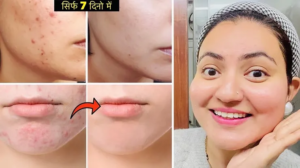Whiteheads and blackheads, commonly referred to as comedones, are two of the most prevalent types of acne lesions.
While they may seem relatively harmless compared to the more severe forms of acne-like cysts or nodules, they can still be a source of frustration and self-consciousness.
To effectively combat and prevent whiteheads and blackheads, it’s essential to understand their underlying causes.
In this article, we’ll explore the reasons behind the formation of these pesky blemishes and provide valuable insights on how to manage and prevent them.
Table of Contents:
Understanding Comedones
Before delving into the causes, it’s crucial to grasp the nature of whiteheads and blackheads. Both are non-inflammatory acne lesions that result from the clogging of hair follicles, known as pores, with a mixture of dead skin cells, oil (sebum), and other debris.
The primary difference between them lies in the state of the pore and its contents:
1]. Whiteheads (Closed Comedones):
-
Whiteheads are tiny, raised bumps with a white or flesh-coloured plug at the surface.
-
The pore is entirely blocked by a thin layer of skin, preventing the trapped material from oxidizing or turning black.
2]. Blackheads (Open Comedones):
-
In contrast, blackheads have an open pore, allowing air to reach the trapped debris.
-
This exposure to oxygen causes the accumulated material to oxidize, turning it dark or black, hence the name “blackhead.”
Comedones are common occurrences in individuals with acne-prone skin and can be found on various parts of the body, although they are most commonly seen on the face, neck, chest, and back.
They can be a source of cosmetic concern and may contribute to a person’s desire to seek treatment or adopt a skincare routine aimed at preventing their formation.
What Causes Whiteheads And Blackheads?
1]. Excess Sebum Production
One of the leading causes of whiteheads and blackheads is an overproduction of sebum, the natural oil produced by your skin’s sebaceous glands.
Several factors can trigger excessive sebum production:
A. Hormonal Changes:
-
Hormones play a significant role in regulating sebum production.
-
During puberty, hormonal fluctuations can increase sebum, making adolescents more prone to comedones.
-
Similarly, hormonal imbalances in adults can contribute to acne breakouts.
B. Genetics:
-
Your genetic makeup can influence the activity of your sebaceous glands.
-
If your parents or close relatives had issues with comedones, you may be more susceptible to them.
C. Medications:
-
Certain medications, such as birth control pills and steroids, can affect hormone levels and lead to increased sebum production.
D. Diet:
-
While the link between diet and acne is complex and varies from person to person, some individuals may experience worsening comedones due to a diet high in dairy products and sugary, processed foods.
2]. Excessive Dead Skin Cell Buildup
Healthy skin continually sheds dead skin cells to make way for new ones. However, when the shedding process disrupts or if you produce an excessive number of skin cells, it can lead to the accumulation of dead cells within your pores.
It is a common cause of comedones, and several factors can contribute to it:
-
Poor Exfoliation: Inadequate exfoliation, whether through skin care products or natural shedding, can leave dead skin cells on the surface and inside pores.
-
Skin Type: Individuals with certain skin types, such as dry or sensitive skin, may be more prone to comedones because their skin doesn’t naturally shed dead cells as effectively.
3]. Bacterial Involvement
-
The presence of bacteria on the skin, particularly Propionibacterium acnes (P. acnes), can exacerbate the formation of comedones.
-
While this bacterium is naturally found on the skin, it can multiply within clogged pores, leading to inflammation and the development of inflammatory acne lesions, such as pustules and cysts.
-
Blackheads and whiteheads can sometimes serve as precursors to these more severe forms of acne.
4]. Cosmetic and Skincare Products
The products you use on your skin can play a significant role in the development of comedones. Some common factors include:
A. Non-comedogenic vs. Comedogenic Products:
-
Non-comedogenic products are formulated to minimize pore-clogging, while comedogenic products may contain ingredients that worsen comedones.
-
It’s essential to choose skincare and makeup products labelled as non-comedogenic, especially if you’re prone to whiteheads and blackheads.
B. Heavy or Occlusive Products:
-
Thick, heavy moisturizers and creams can create a barrier on the skin’s surface, trapping sebum and dead skin cells within the pores.
5]. Environmental Factors
Environmental factors can also contribute to the formation of comedones:
-
Humidity: High humidity can increase sebum production, making your skin more prone to comedones.
-
Pollution: Exposure to pollutants and airborne particles can contribute to clogged pores, especially if not adequately cleansed from the skin.
-
Friction: Constant friction from clothing, headbands, or helmets can exacerbate comedones, particularly on areas like the forehead.
6]. Improper Skincare Habits
Your daily skincare routine can either help prevent or worsen whiteheads and blackheads:
-
Over-cleansing: Excessive cleansing or using harsh, abrasive products can strip your skin of its natural oils, leading to an increase in sebum production as your skin tries to compensate.
-
Inadequate Cleansing: On the other hand, not cleansing your skin thoroughly can allow sebum, dead skin cells, and other debris to accumulate, leading to clogged pores.
-
Picking and Squeezing: Attempting to extract comedones by squeezing or picking at them can push debris deeper into the pore or cause inflammation, making the blemish more pronounced and increasing the risk of scarring.
Conclusion:
Whiteheads and blackheads are common skin concerns that can be managed and prevented with the appropriate knowledge and skincare practices.
Understanding their underlying causes, such as excess sebum production, dead skin cell buildup, bacterial involvement, and environmental factors, is the first step toward clearer, healthier skin.
By adopting a balanced skincare routine, using non-comedogenic products, and avoiding common pitfalls, you can effectively address and minimize the occurrence of these pesky blemishes, ultimately improving your skin’s overall appearance and health.
-
The Ultimate Summer Facial For Fresh, Smooth, and Glowing Skin
-
Get the Ultimate Glowing Skin with this Amazing Natural Parlor Style Facial
-
How To Cure Dark Circles, Puffy and Sunken Eyes Naturally ??
-
Acne Scars, Open Pores, Large Pores & Dark Spots – Best Home Treatment
Also, if you’re not a part of our amazing family, you’re missing out. Join us today and start your natural skincare and haircare journey and get help from other community members. 😊



